The requirement for increased data transfer rates and broader bandwidth in modern Ethernet networks cannot be overemphasized. This necessity has led to an increase in the number of fiber optic multiplexing technologies being developed. Multiplexers allow many signals to combine onto one fiber strand, thus helping us use our current fiber infrastructure effectively. Utilizing this technique not only maximizes the capacity of network backbones but also cuts down on costs incurred while laying more fibers. Advanced performance, scalability, and future-proofing can be achieved within Ethernet networks using Wavelength Division Multiplexing (WDM) methods. This article aims to discuss how fiber optic multiplexer works from a technical point of view, their advantages, and where they can be used in ethernet networks to increase data transmission capabilities.
Understanding the Basics of Fiber Optic Multiplexer

What is a Fiber Optic Multiplexer?
A fiber optic multiplexer is a device that can put together many light signals into one fiber optic by using different light channels or wavelengths. This process allows data networks to carry more information over the same infrastructure, thus improving efficiency. Typically, these devices are used in situations where it is important to maximize the utilization of available fibers, for example, in telecommunication systems and large computer networks. They also make it possible to send multiple streams of data at once, which boosts performance and scalability through methods such as Wavelength Division Multiplexing (WDM).
How Does a Fiber Multiplexer Work?
A fiber optic multiplexer is a device that sends many optical signals together through one optical fiber. The technique employs Wavelength Division Multiplexing (WDM), where different wavelengths of light are given to various data channels or colors. First, each input signal is converted into an optical signal at a specific wavelength. Then, these optical signals are combined into a single output stream by the multiplexer, which mixes the different wavelengths together. A demultiplexer separates them again into individual wavelengths, thereby enabling independent processing for every information flow at the receiver’s end. This approach not only saves on fiber infrastructure but also increases network capacity and efficiency.
The Benefits of Using Fiber Optical Multiplexers
Advantages of Utilizing Fiber Optical Multiplexers in Modern Network Operations:
- More Bandwidth: One single fiber optic can transmit several data streams with the use of a fiber optical multiplexer, thus increasing its capacity and allowing faster rates of data transfer. This is important for environments that require high throughputs, such as telecom networks or data centers.
- Cost-effective: The multiplexer saves on costs by maximizing the utilization of already laid cables; hence, there would be no need to buy more. It is, therefore, cheaper both during installation and maintenance, making it an economical way of expanding network capabilities.
- Scalable: With multiplexers, new channels can be added without necessarily laying down another cable which enhances scalability in networks. This means that as traffic grows over time along with changing data needs, this kind of a network will still be able to cope.
- Performance improvement: The use of wavelength division multiplexing (WDM), among other efficient methods while doing multiplexing, increases the general performance of the whole system because it reduces latency and signal loss. Therefore, long distances are covered by reliable, high-quality transmission.
These benefits show why we cannot do without these devices if we want our information technology infrastructure to be flexible enough for heavier loads while remaining cost effective at all stages of its growth into broad structures suitable for handling large volumes cheaply at higher speeds over wider areas too.
Key Features of Fiber Multiplexers

Understanding the Various Interfaces and Ports
Fiber optic multiplexers have different interfaces and ports that can cater to varying network needs and ensure compatibility with pre-existing infrastructures.
- Optical Ports: These are created to connect optical fibers, which use standard connectors like LC, SC, or ST. They enable the transmission as well as the reception of multiple optical signals.
- Electrical Interfaces: Usually, there will be several electrical interfaces in a multiplexer that support different protocols, such as Ethernet, SONET/SDH, and TDM. This helps integrate seamlessly with electric network components thereby allowing data transportation across both electric and light domains.
- Management Ports: Management ports are important for network administration and monitoring. They give operators access to the multiplexer’s configuration settings along with performance metrics through RS-232, RJ-45 Ethernet, or USB interfaces that enable them to diagnose, update, or maintain their networks efficiently.
- Power Supply Ports: Power is essential in fiber optic multiplexers’ operation reliability. Therefore these devices come equipped with power supply ports meant for supporting AC/DC inputs hence ensuring continuous stable delivery of power into the multiplexer.
Knowing about these various interfaces and ports is crucial because it enables network engineers to deploy fiber-optic multiplexers effectively, thus improving the performance & scalability of networks. These features make sure that Muxes are versatile enough for any type or size network, therefore allowing easy integration and management of complex data networks.
The Role of Wavelength Division Multiplexing (WDM)
Wavelength Division Multiplexing(WDM) is very important for current optical networks as it allows many data channels to be transmitted over a single optical fiber. This technology increases the capacity of the fiber by multiplexing different signals using laser light of various wavelengths(also called colors). WDM can be broadly classified into two types, namely Coarse Wavelength Division Multiplexing(CWDM) and Dense wavelength division multiplexing(DWDM). CWDM has fewer channels, usually up to 18, spaced further apart, which is appropriate for short to medium-range applications. On the other hand, DWDM supports more closely spaced channels, typically up to 80 or even more; this makes it ideal for the long haul and high bandwidth needs. What makes WDM technology so great is that it maximizes the use of already available fiber infrastructure, thus improving network efficiency and scalability without the need for more physical cabling, which saves time and money, too – these are essential features for any service provider in today’s fast-growing digital world where people want everything done instantly at their convenience!
Single Fiber vs. Dual Fiber Multiplexers
In an optical network, single-fiber multiplexers and dual-fiber multiplexers perform different functions. These use one optical fiber for data transmission and reception by incorporating WDM technology to mix up and split signals of various wavelengths. Such a setup can cut down infrastructure costs dramatically and is extremely useful in situations with limited fiber availability. On the other hand, dual fiber multiplexers work with two separate fibers—one strand is used to transmit while another one receives data. This arrangement increases overall bandwidth capacity and reliability, especially when dealing with heavy traffic applications.
The decision whether to go for a single or double fiber configuration largely depends on specific network needs. Single-fiber designs are cost-efficient and effective where there are few demands in terms of data transfer rates; also, they take into account such cases having limited resources of fiber optic cables. Nevertheless, robustness becomes critical, hence making it preferable for larger networks that require higher performance level connectivity, thus making use of dual-fiber solutions. In addition, both types make full use of WDM technology advantages, thereby enabling systems to scale up efficiently while meeting growing demands for information exchange within modern digital infrastructures.
Exploring the Applications of Fiber Optical in Ethernet Networks

Enhancing Ethernet Speeds with Fiber Optic Multiplexers
To hasten Ethernet speeds, fiber optic multiplexers are necessary so that they can enable multiple signals to be transmitted through single optical fibers. This potential is tapped into using Wavelength Division Multiplexing (WDM) and other technologies, which break data into different wavelengths thus multiplying the ability of the current fiber infrastructure. Data rates in Ethernet networks are greatly improved when fiber optics are used; these speeds can reach up to 100 Gbps and beyond.
There are many benefits brought about by including fiber optic multiplexers within Ethernet networks, among them increased bandwidths and reduced latencies. These advantages become even more significant in data centers with high demand or enterprises and telecommunication industries where traffic is heavy most times. The devices ensure the efficiency and reliability of network performance by optimizing the flow of information while avoiding congestion points along transmission lines.
Another advantage associated with these devices is their scalability, which allows for easy upgrades on existing network architecture without much change in physical structures required. This flexibility supports growth in future needs as well as advancements in technology, thus enabling Ethernet networks to meet any demands posed by modern digital applications over time. Hence, it remains true that fiber optics technology plays a critical role in achieving faster and better Ethernet speeds.
Integrating Fiber Multiplexers in Gigabit Ethernet Networks
One method to increase the capacity of a Gigabit Ethernet network is by integrating fiber multiplexers. This involves utilizing more advanced types of multiplexing such as Dense Wavelength Division Multiplexing (DWDM) and Coarse Wavelength Division Multiplexing (CWDM). Through these techniques, it becomes possible to transmit multiple data streams at once over an optical fiber cable by assigning each stream its own wavelength of light. No additional fiber optics will be required; hence, this approach significantly increases the capacity without requiring more fiber optic cables.
Another thing is that network administrators can achieve higher bandwidth and improved data throughput needed for supporting large-scale data transfers while minimizing network congestion through deploying fiber multiplexers. Also, multiplexer usage brings about reduced latency as well as increased overall network efficiency, thus making them indispensable within high-data environments like enterprise networks, cloud services, or data centers with heavy traffic demands.
Typically, the integration process begins with an evaluation of current and future bandwidth needs on the network, followed by the appropriate selection of equipment for multiplexing, after which configuration takes place so as to handle multiple wavelengths across a given system effectively. Such integration should ensure scalability and adaptability to future technologies thereby making the foundation for sustained high-speed connectivity strong enough even in years to come when faster connections become available.
Case Studies: Successful Deployments of Ethernet Fiber Solutions
Case Study 1: Financial Services Firm
A prominent business organization in the field of finance had a problem with data and connection, so they utilized CWDM technology by implementing Gigabit Ethernet fiber solutions. This helped them to have higher bandwidths and less latency through data transmission enhancement capabilities. It made their network perform better, which was necessary for supporting large-scale data analytics as well as real-time financial transactions, thereby saving costs greatly.
Case Study 2: Educational Institution
One of the biggest universities opted for DWDM technology when it came to upgrading its campus network infrastructure. The reason behind this was that before the upgrade, there used to be congestion on networks due to many devices being connected at once, which consumed much bandwidth. This university enabled itself to achieve high speeds throughout different departments within its premises by deploying multiplexers over fiber lines, thus giving each user an opportunity for unlimited e-learning experiences alongside research activities while ensuring reliability, too.
Case Study 3: Healthcare Network
There was a regional healthcare system that encountered problems with moving information between various medical facilities under its umbrella. As part of their gigabit ethernet solutions, these institutions employed fiber multiplexers so as to handle large patient volumes in the form of data together with HD medical imaging files effectively. Each facility required high-speed access to central databases, and this is what exactly happened after using CWDM technology during a process whereby every hospital got connected directly with reliable links, thus promoting telehealth services adoption besides maintaining standards of care for patients who may need them most at any given time but still, it also improved security around sensitive records and helped meet some regulations related to sharing such data.
Navigating the Challenges and Solutions in Fiber Multiplexer Implementation

Compatibility Issues with Existing Fiber Optic Networks
One of the main problems with fiber multiplexers is that they need to be compatible with the current optical fiber networks. This problem comes about due to a number of reasons:
- Diverse Wavelengths: The old fiber optic networks may have been built for different wavelengths from what is used by new multiplexing technologies. For example, DWDM systems must be calibrated very accurately in terms of wavelength so as not to cause interference between channels and ensure optimal performance.
- Connectors and Cables: Different types of fiber connectors (LC, SC or ST) and cables (single-mode versus multi-mode) can create compatibility issues. It is necessary to match them correctly in order not lose or degrade signals.
- Compatibility with Network Equipment: Switches, routers or any other existing network equipment have to work with the new multiplexing technology being used. If they are incompatible it may mean that there will be problems during integration stage which might require upgrading most parts if not all hardware currently installed.
- Signal Attenuation and Dispersion: Old cables tend to suffer more from signal attenuation and dispersion thereby affecting how well multiple signals can be handled by a single line. In such cases one has no option but deal with these physical layer problems through deploying amplifiers or regenerators.
In summary, proper planning, thorough evaluation of what is already on ground as well as possible component upgrades should be done to address compatibility challenges that may arise while introducing fiber multiplexers into existing networks.
Overcoming Signal Loss in Long-Distance Transmissions
To overcome signal loss during long-distance transmissions, there are several strategies that need to be followed for the purpose of maintaining signal quality and ensuring efficient data transfer over large geographical areas. They include:
- Use of Optical Amplifiers: The application of optical amplifiers such as Erbium-Doped Fiber Amplifiers (EDFAs) at fixed intervals helps in increasing the strength of an optical signal without converting it into electrical form. By so doing, this method effectively reduces signal attenuation thus enabling signals to be transmitted over longer distances.
- Dispersion Compensation: Chromatic dispersion is one among major factors which distort signals over long distances. Therefore, dispersion compensating fibers (DCF) or modules should be used to nullify this effect thereby enabling signals maintain their integrity while minimizing inter-symbol interference.
- Advanced Modulation Techniques: Advanced modulation formats like Quadrature Amplitude Modulation (QAM) or Phase-Shift Keying (PSK) can be implemented to achieve better utilization of bandwidth as well as improve signal robustness against noise and attenuation.
- High-Quality Fiber Optic Cables: It is worth investing on good quality single-mode fibers with low losses since they reduce inherent signal loss besides minimizing dispersion too. This will ensure transmission performance is greatly enhanced through use of superior cabling materials.
By combining these methods together, we can solve the problem posed by signal loss in long-distance fiber optic communication, hence making network infrastructures more dependable and high-performing.
Best Practices for Maintenance and Troubleshooting
- Frequent Inspection and Testing: Conduct periodic checks to discover any physical destruction or fiber optic cables and equipment worn out. Use Optical Time-Domain Reflectometers (OTDRs) to ensure the health of the fiber by testing it and locating faults or anomalies.
- Proper Techniques for Cleaning: Clean connectors and fiber ends carefully with approved cleaning solutions and tools. Dust and oil are examples of contaminants that can have a big effect on signal quality; therefore, cleanliness must be maintained for best performance.
- Documenting/Labeling: Keep detailed records about every component, connection point, route, etc., through which fibers pass. This will make troubleshooting easier since there is a clear reference where problems can be looked at quickly.
- Training/Certification: Ensure all personnel involved in maintenance activities or those who may need to troubleshoot are well trained as well certified. A knowledgeable technician is able handle complicated challenges more effectively while following all necessary procedures appropriately.
- Environmental Protection Measures: Protect fiber optic cables against moisture, extreme temperatures and physical stress due to things such as bending. Wherever needed use protective conduit or enclosures so that environmental harm cannot occur.
- Use Of Diagnostic Tools: Make use of diagnostic tools or software programs which help in monitoring network performance live. Power meters, OTDRs and Network analyzers among others can assist identify issues fast enough for them be solved promptly.
Institutions that follow these rules will have their networks serve them longer without failing at any single moment; this makes it easier to troubleshoot, thus reducing downtime.
Bi-Directional and Single Fiber Solutions: What You Need to Know

The Advantages of Bi-Directional Fiber Multiplexers
Fiber multiplexers that allow information to travel in two different directions through a single optical cable are cost-effective because they cut down on the amount of infrastructure needed and the money spent on it. Such devices also improve the use of bandwidth by making it more efficient than traditional systems with individual fibers for each direction. In addition, they help networks scale up their capacity smoothly as demands change over time by providing compatibility between various types of equipment used at different points along a network route. Bi-directional fiber multiplexers thus save costs and increase efficiency and flexibility when designing networks.
Deploying Single Fiber Multiplexers for Efficient Use of Resources
Utilizing solitary fiber multiplexers is a good way to make the most of the already present fiber optic infrastructure. This is achieved by allowing upstream and downstream transmissions through one optical fiber, which effectively doubles the network’s capacity without requiring more physical cables. Such technology becomes particularly useful in situations where laying down new fibers is expensive or difficult in terms of logistics. The main benefits, as per reputable industry sources, include huge cost savings, simplified network design, and better utilization of available resources. Single fiber multiplexers also support various data rates as well as protocols, thus giving room for growth flexibly while scaling with technological advancements in the future. By incorporating them into their systems, establishments can optimize efficiency within their networks, reduce operational expenses greatly, and also simplify deployment processes.
Comparing Single Mode and Multimode Fiber Solutions
To evaluate a one-way fiber and multimode fiber solution, there are many things to think about, including distance, bandwidth, cost, and deployment scenarios. For long-distance communication, single-mode fiber (SMF) operates at 1310 or 1550 nm wavelength. It has a small core diameter of about 9 microns, which enables higher bandwidths to be supported over longer distances without much signal loss. Therefore, it is suitable for use in telecommunication systems and large-scale data centers.
On the other side of the coin, multi-mode fibers are designed for short-range communications within buildings or campuses where very high capacities aren’t required. Normally working at an 850nm wavelength with a much larger core diameter ranging from 50-62.5 µm, MMFs can allow cheaper light sources like LEDs/VCSELs to be used, thus reducing overall system costs, but they have limited bandwidth and distance when compared with SMFs, due to modal dispersion being more pronounced in them.
In conclusion, if you need a lot of bandwidth over long distances – single mode fiber is what you should opt for otherwise choose multimode fiber for its low-cost advantage as well as easy installation features especially in short range applications.
Futuristic Insights: The Evolution of Fiber Optical Multiplexing

The Next Generation of WDM: Expanding Bandwidth and Capacity
The next era of Wavelength Division Multiplexing (WDM) technology is set to revolutionize fiber optic networks. This change is pushed by the need for more bandwidth and space due to the increase in data-driven applications such as cloud computing, 5G networks, and streaming media services.
To date, WDM has improved through Dense Wavelength Division Multiplexing (DWDM) and Coarse Wavelength Division Multiplexing (CWDM) systems. DWDM makes it possible to send data on multiple wavelengths over one fiber, which greatly increases its capacity. Nowadays, DWDM systems can carry up to 80 channels, each running at speeds beyond 100 Gbps, thereby achieving terabits per second on just a single pair of fibers, thus making it ideal for long-distance telecommunication links and large data centers.
Also, there have been advances in hybrid amplifiers including Raman amplifiers as well as Erbium-Doped Fiber Amplifiers (EDFAs) that enhance the efficiency and range of these systems. These amplifiers minimize signal loss while maximizing signal-to-noise ratio hence allowing longer distances between transmission stations without jeopardizing integrity of transmitted data.
Other strategies like Space Division Multiplexing (SDM) are emerging where multiple spatial channels are transmitted via one fiber thus further increasing capacity. When coupled with sophisticated modulation methods plus intelligent network management, these developments will transform optical communications by providing previously unimaginable speeds and capacities that are necessary for future needs.
Emerging Trends in Fiber Optic Multiplexers and Ethernet Networks
The current trends surrounding fiber optic multiplexers and Ethernet networks are geared towards performance improvement, efficiency optimization, and scalability realization in response to the growing data needs. For example, one trend involves combining simple technologies with Quadrature Amplitude Modulation (QAM), which is a high-level modulation technique that boosts spectral efficiency as well as data rates. Moreover, there has been an increase in the adoption of software-defined networking (SDN) and network function virtualization (NFV), which enable flexible programmable architectures at the network level, thus allowing for dynamic allocation and utilization of resources depending on different demands within a network system.
Another notable development entails using Multi-Protocol Label Switching (MPLS) over Ethernet so as to ensure quality of service (QoS) across complex networks while managing traffic more effectively where it matters most. Additionally, terabit-capable Ethernet (TbE) is being created to push network speeds beyond their limits so that data can move faster than ever before with lower latency necessary for real-time analytics powered by artificial intelligence, among others.
These breakthroughs, combined with those made in hybrid fiber-coaxial (HFC) technologies together with passive optical networks (PON), are laying the foundations upon which future broadband services will be established. Next-generation broadband services can be realized by service providers who take advantage of these improvements because they have the ability to deliver high-performing, reliable connectivity that supports heavy data traffic from end-users who may require such support due to increased demand over time.
How Fiber Multiplexers are Shaping the Future of Telecommunications
By increasing the bandwidth and capacity of data transmission, fiber optic multiplexers have revolutionized the telecommunications industry. They merge numerous signals into one optical fiber which not only reduces cabling requirements but also cuts down on infrastructure costs. These devices ensure that long-distance communication is possible with minimal loss of signal quality, thereby guaranteeing high-quality data transfer. Moreover, Dense Wavelength Division Multiplexing (DWDM) allows for multiple channels to be transmitted over different wavelengths, thus maximizing the utilization of available fibers and improving network efficiency. This scalability is necessary to meet rising data needs fueled by 5G and IoT, among other emerging technologies. Telecommunication companies can strengthen their networks’ resilience, flexibility, and scalability through these multiplexers, thus opening doors to future advances in data communication technology.
Reference sources
1. Network Computing – Optimizing Network Efficiency with Fiber Optic Multiplexers
Source Type: Online Article
Summary: Network Computing’s article discusses fiber optic multiplexers and their effect on network efficiency. It provides a technical explanation of how multiplexers improve data transfer in Ethernet networks, as well as discusses where they can be used to increase bandwidth and better the performance of a network. The piece offers some tips for practical use by administrators who are interested in getting more out of fiber-optic multiplexing technology.
2. IEEE Communications Magazine – Advancements in Fiber Optic Multiplexing Techniques
Source Type: Academic Journal
Summary: This academic article, published in IEEE Communications Magazine, is about fiber optic multiplexing methods used in Ethernet networks. The latest technologies and techniques are examined in the study for designing multiplexers so that data throughput can be increased, latency reduced and network scalability optimized. It provides a lot of knowledge for researchers or experts on networking communication systems.
3. Cisco – Fiber Optic Multiplexers Solutions for Enterprise Networks
Source Type: Manufacturer Website
Summary: Cisco has posted information about their fiber optic multiplexer options which were created specifically with enterprise clients’ needs in mind. They provide detailed descriptions such as specifications, compatibility lists, etc., which are necessary when choosing these devices from Cisco’s portfolio; there is also advice on how best to deploy them. Furthermore, this page explains why it is beneficial to use reliability emphasized by this manufacturer, along with performance and scalability aspects highlighted within Ethernet networks themselves.
Frequently Asked Questions (FAQs)
Q: How do fiber optic multiplexers enhance the performance of Ethernet networks?
A: Fiber Optic Multiplexers, or fiber optic muxes, improve Ethernet network performance significantly by combining multiple signals onto one fiber optic cable. In doing so, they enable more efficient use of infrastructure since it reduces the amount of cables and connectors required while increasing total network capacity. With multiplexing, a single strand can carry as much data as several would otherwise be needed hence optimizing speed and slashing costs at the same time.
Q: What is the difference between analog and digital muxes in Ethernet networks?
A: Analog muxes aggregate various analog signals together before transmitting them over a single fiber-optic link, e.g., used in traditional telecommunication systems. On the other hand, a digital multiplexer (mux) combines different digital signals, such as ethernet data streams, which results in higher precision levels plus provision for additional features like error checking that wouldn’t have been possible with an analog system. With this in mind, it’s clear that digital multiplexers are more suited to modern Ethernet networks where high data integrity and speed are vital.
Q: Can fiber optic multiplexers work over a single dark fiber network?
A: Yes, fiber optical multiplexers can work very well on one dark fiber network. The reason behind this lies with Wavelength Division Multiplexing (WDM) technology which makes it possible to send various channels (ch) of data simultaneously through a mono-mode fiber by using different wavelengths. With such kind of technology, even one alone fiber optics may be utilized fully to deliver ethernet services to their clients without any need for additional physical cables.
Q: How do SDH multiplexers differ from Ethernet muxes?
A: SDH (Synchronous Digital Hierarchy) multiplexers are mainly used in telecommunications networks where they combine many digital bit streams derived from different sources onto an optical fiber using lasers or LEDs.Similarly, Ethernet Muxes also combine various signals together but only focus on routing, aggregation and optimization of ethernet data packets. Ethernet muxers are designed for local area network (LAN), wide area network (WAN), and internet data transfers, making them more versatile in data networking scenarios as compared to SDH multiplexors, which concentrate more on telecommunication standards and provide high-level synchronization for transferring phone calls and data.
Q: In network setups, what good does a demultiplexer do when compared to a multiplexer?
A: The good thing about the demultiplexer, which is the opposite of the multiplexer in terms of networking, is that it can split back the combined signals into individual original signals at an efficiency. This becomes necessary at the receiving point of a network connection, where data for different channels has to be correctly directed. Demultiplexers allow for the identification and transmission of bundled signals over a single fiber optic cable within the network as separate, hence preserving data stream integrity and sequence.
Q: What is done by multiplexers so that Ethernet data can be transmitted through single-mode fiber?
A: They enable only one light mode to pass through, thus eliminating modal dispersion, which then increases the distance covered by the information carried and the speed at which it gets there. This greatly benefits Ethernet networks used for long-haul connectivity with minimum signal attenuation or latency between points. Multiplexers take advantage of capacity and attenuation properties inherent in single-mode fibers by combining several streams from different Ethernets into one light signal, thereby achieving efficient data communication performance.
Q: What are some benefits that Ethernet networks derive from using muxes alone with T1 or E1 interfaces?
A: They offer great flexibility and connectivity advantages within Ethernet networks especially in terms of their ability to work with other systems seamlessly. These gadgets make it possible for traditional telephony lines such as T1 or E1 to be integrated with modern-day Ethernet networks, thereby enabling easy sharing of information across diverse types of networks. For businesses that need both legacy telecommunications services alongside simultaneous access to Ethetnet, this provides cheap solutions as they also enhance interoperability among various parts within a given system. Moreover, these devices have got multi input/output channels support feature, which makes them ideal options for expanding sizeable Ethernet-based setups.
Related Products:
-
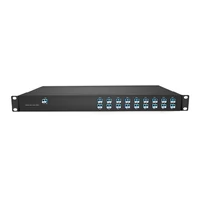 Passive CWDM Double Fiber Mux & Demux Module 18 CH (1270-1610nm) LC/UPC 1U Rack
$630.00
Passive CWDM Double Fiber Mux & Demux Module 18 CH (1270-1610nm) LC/UPC 1U Rack
$630.00
-
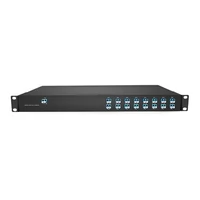 Passive CWDM Double Fiber Mux & Demux Module 16 CH (1310-1610nm) 1U Rack
$570.00
Passive CWDM Double Fiber Mux & Demux Module 16 CH (1310-1610nm) 1U Rack
$570.00
-
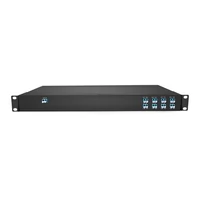 CWDM MUX 8CH 16 Wavelengths (TX: 1310/1330/1390/1410/1470/1490/1550/1570nm RX: 1350/1370/1430/1450/1510/1530/1590/1610nm) LC/UPC Single Fiber 1U Rack
$320.00
CWDM MUX 8CH 16 Wavelengths (TX: 1310/1330/1390/1410/1470/1490/1550/1570nm RX: 1350/1370/1430/1450/1510/1530/1590/1610nm) LC/UPC Single Fiber 1U Rack
$320.00
-
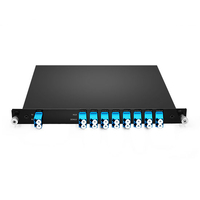 Passive CWDM Double Fiber Mux & Demux Module 8CH (1470-1610nm) LC/UPC LGX BOX
$280.00
Passive CWDM Double Fiber Mux & Demux Module 8CH (1470-1610nm) LC/UPC LGX BOX
$280.00
-
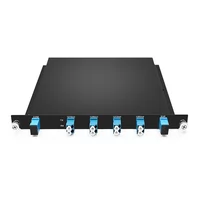 CWDM MUX 4CH 8 Wavelengths (TX: 1470/1490/1510/1530nm RX: 1550/1570/1590/1610nm) with Express Port LC/UPC Single Fiber LGX BOX
$150.00
CWDM MUX 4CH 8 Wavelengths (TX: 1470/1490/1510/1530nm RX: 1550/1570/1590/1610nm) with Express Port LC/UPC Single Fiber LGX BOX
$150.00
-
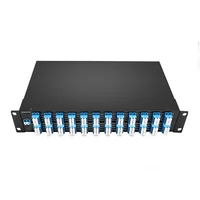 DWDM MUX DEMUX 50GHZ 96CH (C15-C62) LC/UPC Dual Fiber 2U Rack
$6000.00
DWDM MUX DEMUX 50GHZ 96CH (C15-C62) LC/UPC Dual Fiber 2U Rack
$6000.00
-
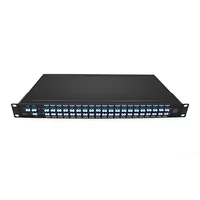 DWDM MUX DEMUX 40CH (C21-C60) LC/UPC Dual Fiber 1U Rack
$1100.00
DWDM MUX DEMUX 40CH (C21-C60) LC/UPC Dual Fiber 1U Rack
$1100.00
-
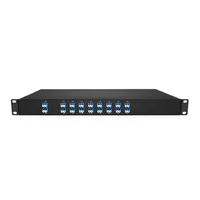 DWDM MUX DEMUX 16CH (C21-C36) with Monitor Port LC/UPC Dual Fiber 1U Rack
$800.00
DWDM MUX DEMUX 16CH (C21-C36) with Monitor Port LC/UPC Dual Fiber 1U Rack
$800.00
-
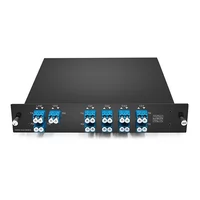 DWDM MUX DEMUX 8CH (C21-C28) with Express Port LC/UPC Dual Fiber LGX BOX
$500.00
DWDM MUX DEMUX 8CH (C21-C28) with Express Port LC/UPC Dual Fiber LGX BOX
$500.00
-
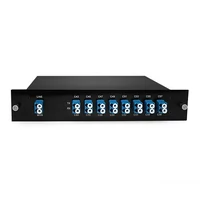 DWDM MUX 8CH 16 Wavlengths (TX: C43/C45/C47/C49/C51/C53/C55/C57 RX: C44/C46/C48/C50/C52/C54/C56/C58) with MON Port LC/UPC Single Fiber LGX BOX
$450.00
DWDM MUX 8CH 16 Wavlengths (TX: C43/C45/C47/C49/C51/C53/C55/C57 RX: C44/C46/C48/C50/C52/C54/C56/C58) with MON Port LC/UPC Single Fiber LGX BOX
$450.00
